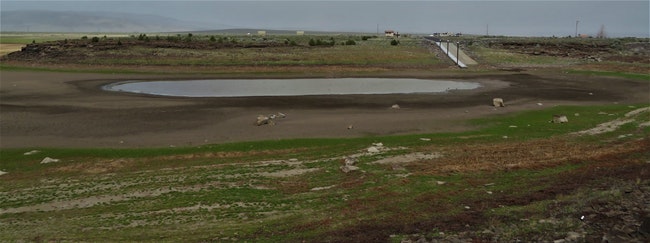
Chickahominy Reservoir, about 100 miles east of Bend on U.S. Highway 20, shows the effects of persistent drought in eastern Oregon. Photo taken May 7, 2022 (Courtesy/Harry Fuller)
Here in the Willamette Valley as of mid-May, we are slightly above average for seasonal precipitation. That is not true for the rest of Oregon, where the 22-year long drought continues as it does over much of the western U.S.
I’ve been birding in Harney County recently, where drought effects became painfully obvious. Mudd Lake, Harney Lake and Wright’s Pond exist on maps. In reality they are arid steppe. Harney is one of several counties (collectively over half the state) that Governor Kate Brown has declared to be in a state of drought emergency.
Teresa Wickes, PhD, is Portland Audubon Society’s Eastern Oregon Field Coordinator, and an expert field ornithologist. I spoke with her about what can be determined about the drought’s effect on nesting birds.
As long as there is sufficient water and food many “waterfowl” can thrive or, at least, survive. Yet, some large birds are being negatively affected.
Trumpeter swans last nested successfully at Malheur in 2015-17. White pelicans raised no young last year and may not this year. They feed on reduced Malheur Lake, but are not breeding. Their last good year was 2020.
 A trumpeter swan in Minnesota (Courtesy/Marc Reigel)
A trumpeter swan in Minnesota (Courtesy/Marc Reigel)
Sandhill cranes nested and hatched young last year–but likely none of those colts matured to migrate out. Baked earth makes it difficult for even adult cranes to dig out enough food. These three large species are long-lived, comparatively. Swans and cranes can live twenty years, pelicans over sixteen. One or two lost breeding seasons may not be a long-term danger. If the drought continues or worsens so will the effects.
The Malheur Basin is again below normal for the “rainy” season. The snowpack is slightly above average but not adequate for drought recovery. Fotr a second straight year a drive down Ruh-Red Road takes you to a bridge across waterless Silvies “River.” No Silvies water flows into Malheur Lake. It’s being pumped dry by ranchers. Malheur Lake is now about one-fifth of its normal 50,000 acre surface area. In capacity years it’s five feet deep. In much of its current area, the lake’s only inches deep.
 The pond at Malheur National Wildlife Refuge Headquarters on Sodhouse Road on May 8, 2022 (Courtesy/Harry Fuller)
The pond at Malheur National Wildlife Refuge Headquarters on Sodhouse Road on May 8, 2022 (Courtesy/Harry Fuller)
I spoke with Oregon Fish & Wildlife biologists about drought effects in eastern Oregon. One said young male bighorn sheep in ideal habitat add 6 to 8 inches to horn length yearly; horns can be read like tree rings. He is now seeing horn growth of a mere ¼ to 1/8 inch. Bighorns are barely SURVIVING.
Mule deer east of Hart Mountain find little forage in late summer. Higher elevations do not stay wet longer than the lowlands. Young deer learn seasonal routes from their mothers and as habitat dries, deer suffer from lack of nutrition as winter approaches. Without sufficient fat reserves mammals and birds cannot survive eastern Oregon winters or migrate successfully.
The biologist warned that even drought-resistance junipers are losing limbs and bearing less fruit.
Another biologist said amphibia are especially at risk. As adults, female frogs and salamanders return to their birthplace to lay eggs. If those streams, lakes, or marshes are dry or have low water, eggs or young will not survive.
Down south
Friends in Jackson County. Oregon, keep me informed. Three reservoirs that have been great birding in times past are almost gone: Emigrant Lake is 7% full; Hyatt Lake 6%; Howard Prairie Lake 7%. I have seen each of these lakes overflow during spring a decade ago. In recent years Howard Prairie was usually home to four or five nesting pairs of bald eagles. A local raptor expert tells me evidently only one pair managed to fledge young there last year. The low level of the lake meant there was little fish to catch, forcing eagles to hunt or scavenge elsewhere.
For information about upcoming Salem Audubon programs and activities, see www.salemaudubon.org, or Salem Audubon’s Facebook page.
Harry Fuller is an Oregon birder and natural history author of “Freeway Birding.” He is a member of the Salem Audubon Society. Contact him at [email protected] or atowhee.blog. His “Some Fascinating Things About Birds” column appears regularly in Salem Reporter.
JUST THE FACTS, FOR SALEM – We report on your community with care and depth, fairness and accuracy. Get local news that matters to you. Subscribe to Salem Reporter starting at $5 a month. Click I want to subscribe!









